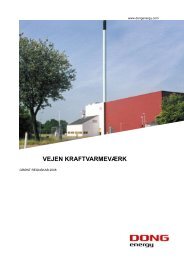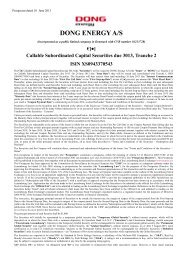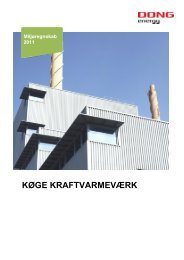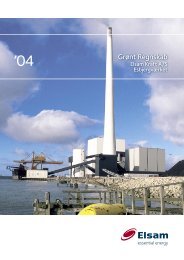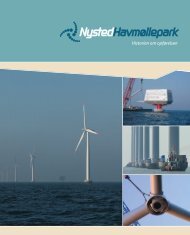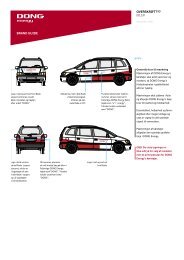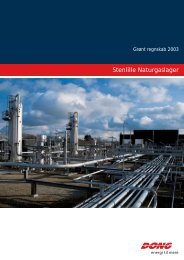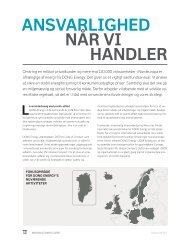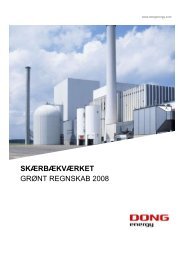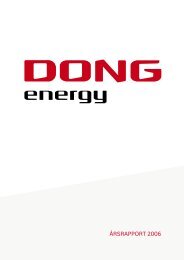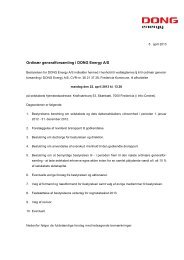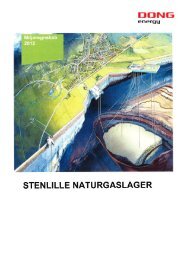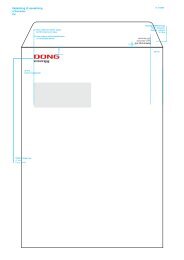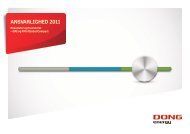ANNUAL REPORT 2011 - DONG Energy
ANNUAL REPORT 2011 - DONG Energy
ANNUAL REPORT 2011 - DONG Energy
You also want an ePaper? Increase the reach of your titles
YUMPU automatically turns print PDFs into web optimized ePapers that Google loves.
notes<br />
22 Equity<br />
share capital<br />
DKK million <strong>2011</strong> 2010<br />
Share capital at 1 January 2,937 2,937<br />
share capital at 31 December 2,937 2,937<br />
The company’s share capital is DKK 2,937,099,000, divided<br />
into shares of DKK 10. All shares rank equally. There are no<br />
restrictions on voting rights. The shares are fully paid up. The<br />
shares may only be assigned or otherwise transferred with the<br />
written consent of the Danish Finance Minister.<br />
Resolutions concerning amendments to the Articles of<br />
Association or <strong>DONG</strong> <strong>Energy</strong> A/S’s dissolution require at least<br />
two thirds of the votes cast and of the voting share capital to<br />
be represented at the general meeting in order to be carried.<br />
Dividends<br />
The Board of Directors recommends that dividend of DKK 1,457<br />
million be paid for the <strong>2011</strong> fi nancial year, equivalent to 60% of the<br />
business performance result determined as the share of the business<br />
performance result after tax (i.e. excluding coupon to hybrid<br />
capital holders and non-controlling interests) that is attributable<br />
to the company’s shareholders, equivalent to DKK 4.96 per share<br />
(2010: DKK 7.50 per share). It is the Board of Directors’ intention<br />
to distribute DKK 7.75 per share in 2012, and, in the years after the<br />
2012 fi nancial year and until a decision, if any, on an IPO is made,<br />
to generally increase distributions by DKK 0.25 per share per year,<br />
although in such a way that the payout ratio does not fall below<br />
40% or exceed 60% of the business performance result for the<br />
year determined as the shareholders’ share of the business performance<br />
result after tax (i.e. excluding coupon to hybrid capital<br />
holders and non-controlling interests).<br />
Dividend distributions to shareholders have no tax implications<br />
for <strong>DONG</strong> <strong>Energy</strong> A/S. Dividend paid per share (DPS) of DKK 10<br />
amounted to DKK 7.50 (2010: DKK 1.64).<br />
Cash management and capital structure<br />
Management continuously evaluates the Group’s capital<br />
structure to ensure that it is aligned with the Group’s and the<br />
shareholders’ interests and supports the Group’s strategy.<br />
<strong>DONG</strong> <strong>Energy</strong>’s liquidity and fi nancing risks are managed centrally<br />
in accordance with principles and delegated authorities<br />
laid down by the Board of Directors. One of the most important<br />
fi nancial management tasks in <strong>DONG</strong> <strong>Energy</strong> is to secure<br />
suffi cient and fl exible fi nancial resources in relation to the dayto-day<br />
operations and the Group’s investment programme.<br />
To this end, internal management targets have been set for<br />
the required level of fi nancial resources, taking into account<br />
primarily factors such as the investment programme, cash<br />
fl ows from operating activities and debt maturity profi le.<br />
Equity, hybrid capital and bond and mortgage loans are considered<br />
to be capital.<br />
It is <strong>DONG</strong> <strong>Energy</strong>’s fi nancing policy to concentrate loans in<br />
the parent company in order to optimise the loan portfolio on a<br />
consolidated basis. Non-current assets are primarily fi nanced<br />
by cash fl ows from operating activities, supplemented by the<br />
raising of debt.<br />
<strong>DONG</strong> <strong>Energy</strong> manages its debt profi le and cash resources via<br />
various policies aimed at minimising refi nancing risks. This is<br />
achieved partly via a spread of sources of funding and maturities,<br />
and partly by ensuring that cash resources are sound, either<br />
in the form of committed borrowing facilities or cash and cash<br />
equivalents. At the end of <strong>2011</strong>, cash resources stood at DKK 23.1<br />
billion, including undrawn committed borrowing facilities of DKK<br />
13.4 billion and cash and securities of DKK 9.7 billion.<br />
To secure fi nancing on attractive terms at all times, <strong>DONG</strong><br />
<strong>Energy</strong> has set targets for its credit rating and capital structure.<br />
The credit rating target is to maintain ratings of at least<br />
BBB+ and Baa1 respectively with the rating agencies Standard<br />
& Poor’s and Moody’s. <strong>DONG</strong> <strong>Energy</strong> considers that poorer<br />
ratings would restrict its scope for effective implementation of<br />
the investment programme that is part of its strategy. <strong>DONG</strong><br />
<strong>Energy</strong> has been rated A- by Standard & Poor’s and Baa1 by<br />
Moody’s, both with a stable outlook.<br />
Up to and including <strong>2011</strong>, the capital structure target was for<br />
adjusted net debt not to exceed three times cash fl ows from<br />
operating activities. From and including 2012, the target has<br />
been changed so that adjusted net debt must not exceed 2.5<br />
times EBITDA.<br />
Hybrid capital<br />
96 100 COnsOliDatED finanCial statEmEnts – <strong>DONG</strong> ENERGY GROUP <strong>ANNUAL</strong> <strong>ANNUAL</strong> <strong>REPORT</strong> <strong>REPORT</strong> <strong>2011</strong><br />
<strong>2011</strong><br />
The hybrid capital totalling DKK 9,538 million (EUR 1.3 billion<br />
nominal value) comprises the EUR hybrid bonds issued<br />
in the European capital markets to which a series of special<br />
terms are attached. The hybrid capital is subordinate to the<br />
Group’s other creditors. The purpose of issuing hybrid capital<br />
was to strengthen the Group’s capital base and to fund<br />
the Group’s CAPEx and acquisitions.<br />
The total hybrid capital consists of hybrid bonds due in 3005<br />
and hybrid bonds due in 3010. Further details of the two hybrid<br />
capital issues are given in the table below.<br />
Coupon on the hybrid capital is settled annually. Coupon payments<br />
and their tax effect are recognised directly in equity.



